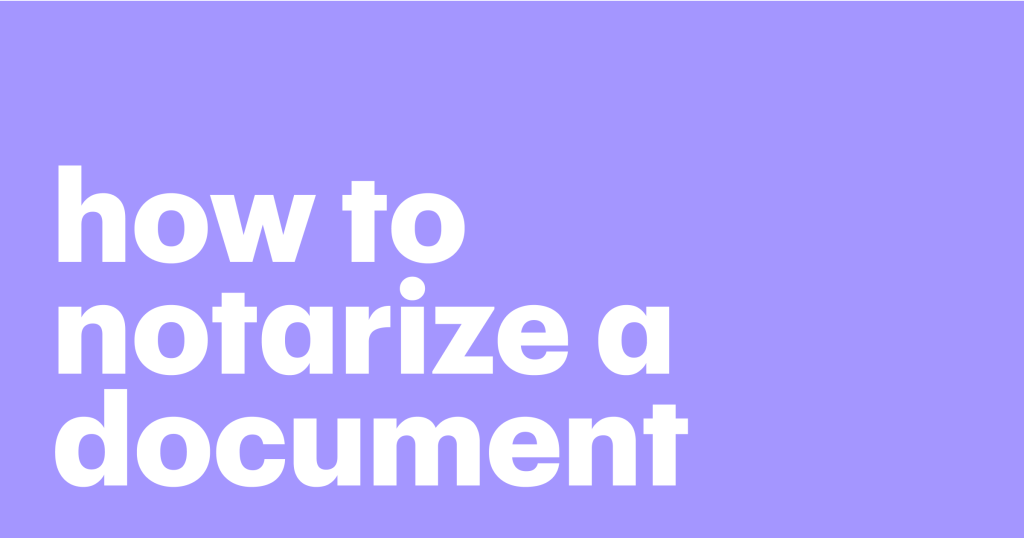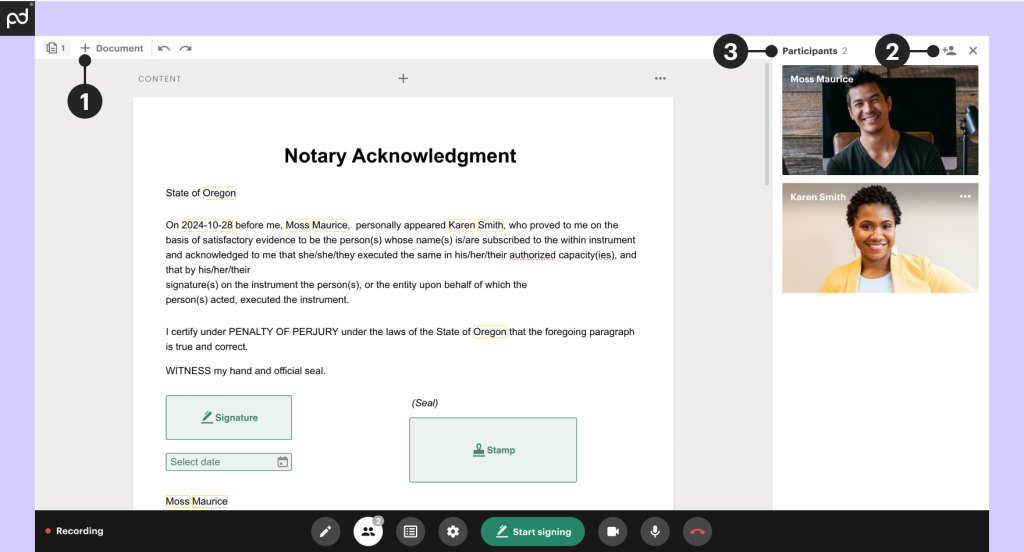How to notarize a document

Many of us have had to notarize a document and wondered what to do and where to go. While the process may seem complicated, notarizing personal or business documents doesn’t need to be stressful.
Understanding how to organize and prepare a document for notarization can help ensure the process goes as smoothly as possible.
This short guide covers everything you need to know about the different types of notarization, common questions about the notarization process, and how to notarize a document quickly and easily.
What does it mean to notarize a document?
Notarization is necessary for verifying the signer’s identity and preventing fraud.
When a document is notarized, a public official, known as a notary or notary public, ensures everything is completed correctly, that signers understand the contents of the document, and that the people signing are who they say they are.
What is a notary?
A Notary Public is an official appointed by a state government to serve as an impartial witness.
Which types of documents need to be notarized?
There are several different types of documents that need to be notarized.
Some examples include the following:
- Financial documents: Loan agreements, real estate deeds, and more.
- Business documents: Some employment contracts, articles of incorporation, and client agreements.
- Legal documents: Wills, trusts, custody agreements, power of attorney, affidavits, etc.
- Personal documents: Marriage licenses, medical documents, and more.
Who can notarize a document?
In the U.S., only a notary public can notarize a document.
If you need to get a document notarized, you can often find a notary public at local banks, law offices, or shipping stores like FedEx or UPS. Some mobile notaries can also be found online or in person.
You can also search for a notary near you.
Remote Online Notarization (RON) vs. traditional notarization
Two of the most common ways to notarize a document include remote online notarization (RON) and traditional notarization.
As the name implies, remote online notarization(RON) means documents can be signed online, using video and audio for the notary/witness.
When we talk about “traditional” notarization, we are specifically referring to services that require you to meet with a public notary in person, face to face.
Benefits of Remote Online Notarization
The biggest benefit of RON vs. traditional notarization is convenience.
Signers don’t have to be in the same place at the same time and can sign documents from almost anywhere with a secure internet connection.
Other benefits include:
- Convenience. No time wasted on scheduling an appointment to meet with a notary and having to wait for them to have an opening.
- Cost-savings. Eliminates excessive fees and services, such as those associated with a mobile/traveling notary.
- Faster process. Allows you to meet with a notary online and complete a signature within minutes, whenever you need it.
- Increased security. Multi-factor, knowledge-based identity verification of all signers offers document security.
- Access to records. A detailed digital record of the entire notarial transaction is kept, stored, and accessible for all signers.
RON is 100% online, which means you can notarize your documents at your convenience, regardless of any outside factors that may have otherwise stalled the process down.
When you need notarization services, it’s helpful to consider your personal needs first.
With the ease, convenience, and security that Remote Online Notarization provides, there’s never been an easier or cheaper way to securely prepare, eSign, and notarize a document.
PandaDoc offers RON services to help you securely sign and notarize legally binding documents remotely.
In this table, you can see the difference between RON vs. traditional notarization and the pros and cons.
Traditional notarization vs. remote online notarization
| Type | Benefits | Location | Accessibility | Cost |
|---|---|---|---|---|
| Traditional | In-person verification and physical witness- Offers security since notary and witnesses are there to verify documents and confirm the signers understand what they’re signing | – Banks – Shipping centers – Law offices | Limited by business hours and notary schedule and location | Standard fee per signature (check your location)- Additional costs can include travel fees (for mobile notary or if signers are in different locations) |
| RON | Convenience (Notarize documents anywhere and don’t need to coordinate travel)- Cost-savings (Eliminates excessive fees and services)- Document security (Multi-factor identification)- Detailed digital records for all singers | Anywhere with an internet connection and video/audio | 24/7 access depending on service provider | Pricing per session or document depending on the provider/app- Might have service fees or subscription models |
What are the different types of notarization?
The two types of traditional notarization are walk-in notaries and traveling/mobile notaries.
Here’s how the two traditional notarization services differ:
- Walk-In Notary: You schedule a time with your signers to visit a notary public at their office and pay a fee to have your document(s) notarized in person.
- This service typically requires advanced scheduling and a bit of a time commitment, as you will have to account for travel time, expenses, and potential delays.
- Travelling & Mobile Notary: For a fee, you schedule a place and time in advance for a mobile notary public to come to you to notarize your documents in person.
- While this is more convenient than visiting a walk-in notary, it is also usually the most expensive option, as you will have to pay extra for the notary’s travel expenses and time.
- Mobile notary services usually take the longest to arrange, as you are at the whim of the traveling notary’s schedule and availability.
- Remote Online Notarization (RON): RON allows you to skip the inconvenience and fees associated with traditional notarization services and complete notarization virtually online, from any location..
RON is quickly becoming the preferred notarization method for individuals and SMBs alike because of its convenience.
Notarizing a document online eliminates the need for coordinating in-person meetings and reduces the cost and planning involved for travel.
Online notarization is permitted in a majority (44) of states, making it easier than ever to notarize important documents.
How to notarize a document (step-by-step guide)
Below, you will find a step-by-step guide on how to notarize a document with RON and traditional notary services.
Please keep in mind that these are general guidelines, and the requirements may vary by state, some items, such as wills and real estate documents, require a credible witness to be present to confirm the signer’s identity.
Traditional notarization
- Before you meet with a notary, you must create and fill out the document that you need notarized, leaving blank spaces for the signatures. Since the notary must witness all parties signing the document firsthand for it to be considered valid, it’s important that you leave all of the signatures blank.
- Ensure the document has a spot for the notary to sign and add a notary seal.
- It may be necessary to have a lawyer review your documents before notarization in order to ensure the document is legal and accurate. Unfortunately, this adds time and extra cost to the preparation stage.
- Once you are sure the document is correct, make a copy for notarization.
- You must also provide copies to all signing parties in advance of the notarization session to review. They may hire a lawyer to review the document or request changes, potentially slowing down the process.
- At this point, you will need to locate and contact a notary to schedule a time and place for you, any additional signers, and the notary to meet to complete the notarization. You can research your local options online; however, banks, courthouses, and other financial institutions often provide notarization services for a fee. If you choose to go with a mobile notary, you will have to schedule a time and place for them to meet you according to their availability.
- All signing parties will need to bring some form of verifiable ID, such as a driver’s license, state-issued ID, or passport, to confirm their identity prior to signing. These must be current, up-to-date government-issued IDs that include a photo and signature.
- Prior to signing, the notary will review the signer’s forms of identity to ensure the signature is valid.
- The notary will then watch the signers all sign and date the document in the predetermined locations. Note: The date on the document must be the date of notarization, not when you prepared the documents.
- The notary will then provide their signature and seal, thereby officially notarizing the document. They will then apply their notarial seal and record the transaction in their notarial journal in accordance with local state laws.
How to notarize documents online?
Online notarization simplifies the process of document preparation by allowing you to create, edit, eSign, and notarize your documents all in one place.
Here’s how to notarize a document online using PandaDoc.

- Select a PandaDoc document to work with. You can create your own or use a premade template.
- Add participants to invite.
- Participants can join and select their camera and microphone.
- Each participant enters their personal information and answers a few knowledge-based authentication questions inside the secure portal.
- Participants complete ID verification by uploading a government-issued ID
- Once this is complete, you can start the live session and review and sign the document. You can see participants alongside the document.
- Your document(s) and session recording(s) are available for download in your library.
How to notarize a document FAQ
Find the answers to common questions about the notarization process.
Can I notarize a document for myself?
Even if you fully understand what you are signing, you cannot notarize a document for yourself. A notary public acts as an impartial witness to prevent fraud and conflicts of interest.
Where can I notarize a document?
You can notarize a document at several different places, including:
- Shipping stores like FedEx and UPS
- Local banks
- Some libraries
- Notarization apps
Find a notary near you.
Why does a document need to be notarized?
The notarization process prevents document fraud and protects the signer’s personal rights. The notary’s presence helps to confirm that the signer understands and is willing to sign the document or agreement.
How much does it cost to notarize a document?
Notary fees vary depending on several factors, including the type of document, state or location, and the type of notary (in-person vs. online).
States determine the fees notaries may charge for notarial acts.
Learn more about notary fees by state.
How long does the notarization process take?
Timing also depends on factors like the type of document, location, and type of notarization (traditional vs. RON).
The average time for notaries to process a document is between 10 and 15 minutes.
Begin notarizing documents with PandaDoc Notary today
When you need documents notarized fast, RON makes it as easy as possible to capture your signatures without the hassle and fees associated with traditional notarization services.
Hopefully, this guide has helped you understand how to notarize a document and why remote notarization is the clear choice for all of your notarization needs.
There is simply no better option when it comes to the ease, security, and flexibility that RON offers compared to traditional notarization.
PandaDoc Notary provides an easy-to-use and secure Remote Online Notarization platform that helps you create, edit, eSign, and notarize documents at your from anywhere.
The all-in-one platform makes it simple and secure to notarize when you need it. To learn more about how PandaDoc Notary can help you, request a demo.